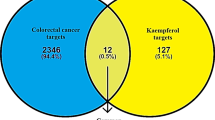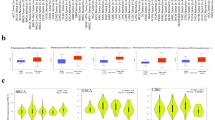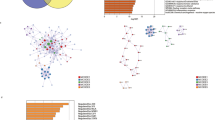Abstract
Background
Colorectal cancer (CRC) is the most common primary malignancy. Recently, antineoplastic attributes of homoharringtonine (HHT) have attracted lots of attention. This study investigated the molecular target and underlying mechanism of HHT in the CRC process by using a cellular and animal models.
Methods
This study first detected the effects of HHT on the proliferation, cell cycle and apoptosis ability of CRC cells using CCK-8, Edu staining, flow cytometry and Western blotting assay. In vitro recovery experiment and in vivo tumorigenesis experiment were used to detect the targeted interaction between HHT and NKD1. After that, the downstream target and mechanism of action of HHT targeting NKD1 was determined using quantitative proteomics combined with co-immunoprecipitation/immunofluorescence assay.
Results
HHT suppressed CRC cells proliferation by inducing cell cycle arrest and apoptosis in vitro and vivo. HHT inhibited NKD1 expression in a concentration and time dependent manner. NKD1 was overexpressed in CRC and its depletion enhanced the therapeutic sensitivity of HHT on CRC, which indicating that NKD1 plays an important role in the development of CRC as the drug delivery target of HHT. Furthermore, proteomic analysis revealed that PCM1 participated the process of NKD1-regulated cell proliferation and cell cycle. NKD1 interacted with PCM1 and promoted PCM1 degradation through the ubiquitin-proteasome pathway. The overexpression of PCM1 effectively reversed the inhibition of siNKD1 on cell cycle.
Conclusions
The present findings revealed that HHT blocked NKD1 expression to participate in inhibiting cell proliferation and inducing cell apoptosis, ultimately leading to obstruction of CRC development through NKD1/PCM1 dependent mechanism. Our research provide evidence for clinical application of NKD1-targeted therapy in improving HHT sensitivity for CRC treatment.







Similar content being viewed by others
Data availability
The datasets used and/or analyzed during the current study are available from the corresponding author on reasonable request.
References
Fu M, Pan S, Cai X, Hu Y, Zhang W et al (2022) Analysis of ARHGAP4 expression with colorectal Cancer clinical characteristics and prognosis. Front Oncol 12:899837
Xu M, Xu X, Pan B, Chen X, Lin K et al (2019) LncRNA SATB2-AS1 inhibits tumor metastasis and affects the tumor immune cell microenvironment in colorectal cancer by regulating SATB2. Mol Cancer 18(1):135
Micu B, Vesa Ş, Pop T and C (2020) Micu. Evaluation of prognostic factors for 5 year-survival after surgery for colorectal cancer. Ann Ital Chir 91:41–48
Li C, Dong L, Su R, Bi Y, Qing Y et al (2020) Homoharringtonine exhibits potent anti-tumor effect and modulates DNA epigenome in acute myeloid leukemia by targeting SP1/TET1/5hmC. Haematologica 105(1):148–160
Gandhi V, Plunkett W, Cortes J (2014) Omacetaxine: a protein translation inhibitor for treatment of chronic myelogenous leukemia. Clin cancer research: official J Am Association Cancer Res 20(7):1735–1740
Yakhni M, Briat A, El Guerrab A, Furtado L, Kwiatkowski F et al (2019) Homoharringtonine, an approved anti-leukemia drug, suppresses triple negative breast cancer growth through a rapid reduction of anti-apoptotic protein abundance. Am J cancer Res 9(5):1043–1060
Chen X, Zhang W, Chen B, Xi W, Lu Y et al (2019) MYC homoharringtonine deregulates transcriptional expression by directly binding NF-κB repressing factor. Proc Natl Acad Sci USA 116(6):2220–2225
Guo S, Bai X, Shi S, Deng Y, Kang X et al (2021) TMEM16A, a homoharringtonine receptor, as a potential endogenic target for Lung Cancer Treatment. Int J Mol Sci 22(20):10930
Wang L, Zhao L, Wei G, Saur D, Seidler B et al (2018) Homoharringtonine could induce quick protein synthesis of PSMD11 through activating MEK1/ERK1/2 signaling pathway in pancreatic cancer cells. J Cell Biochem 119(8):6644–6656
Zhu M, Gong Z, Wu Q, Su Q, Yang T et al (2020) Homoharringtonine suppresses tumor proliferation and migration by regulating EphB4-mediated β-catenin loss in hepatocellular carcinoma. Cell Death Dis 11(8):632
Wang L, Wang D, Wu L, Cao J, Tian J et al (2021) Homoharringtonine inhibited breast cancer cells growth via miR-18a-3p/AKT/mTOR signaling pathway. Int J Biol Sci 17(4):995–1009
Shi X, Zhu M, Gong Z, Yang T, Yu R et al (2020) Homoharringtonine suppresses LoVo cell growth by inhibiting EphB4 and the PI3K/AKT and MAPK/EKR1/2 signaling pathways. Food and chemical toxicology: an international journal published for the British Industrial Biological Research Association 136:110960
Qu M, Li J, Yuan L (2021) Uncovering the action mechanism of homoharringtonine against colorectal cancer by using network pharmacology and experimental evaluation. Bioengineered 12(2):12940–12953
Katoh M (2001) Molecular cloning, gene structure, and expression analyses of NKD1 and NKD2. Int J Oncol 19(5):963–969
Zhang S, Wang Y, Dai S, Wang E (2011) Down-regulation of NKD1 increases the invasive potential of non-small-cell lung cancer and correlates with a poor prognosis. BMC Cancer 11:186
Lv Z, Zhang L, Liu X, Jin L, Dong Q et al (2015) NKD1 down-regulation is associated with poor prognosis in breast invasive ductal carcinoma. Int J Clin Exp Pathol 8(4):4015–4021
Zhang S, Li J, Yin Z, Liu P, Zhao W et al (2015) Expression pattern and clinicopathologic significance of NKD1 in human primary hepatocellular carcinoma. APMIS: acta pathologica, microbiologica. Immunol Scand 123(4):315–320
Wang Y, Yang C, Li W, Shen Y, Deng J et al (2021) Identification of colon tumor marker NKD1 via integrated bioinformatics analysis and experimental validation. Cancer Med 10(20):7383–7394
Jia Cao X, Wang D, Wang R, Ma et al (2019) PGC-1β cooperating with FOXA2 inhibits proliferation and migration of breast cancer cells. Cancer Cell Int 19:93
Durinikova E, Reilly N, Buzo K, Mariella E, R Chilà (2022) Targeting the DNA damage response pathways and replication stress in Colorectal Cancer. Clin cancer research: official J Am Association Cancer Res 28(17):3874–3889
Haider M, Zaki K, Hamshary ME, Hussain Z, Orive G et al (2022) Polymeric nanocarriers: a promising tool for early diagnosis and efficient treatment of colorectal cancer. J Adv Res 39:237–255
Wei W, Huang S, Ling Q, Mao S, Qian Y et al (2022) Homoharringtonine is synergistically lethal with BCL-2 inhibitor APG-2575 in acute myeloid leukemia. J translational Med 20(1):299
Yuan F, Li D, Li G, Cheng C, Wei X (2022) Synergistic efficacy of homoharringtonine and venetoclax on acute myeloid leukemia cells and the underlying mechanisms. Annals of translational medicine 10(8):490
Porcù E, Maule F, Manfreda L, Mariotto E, Bresolin S (2022) Identification of Homoharringtonine as a potent inhibitor of glioblastoma cell proliferation and migration. Translational research: the journal of laboratory and clinical medicine (22):151–157
Zhang J, Gan Y, Li H, Yin J, He X (2022) Inhibition of the CDK2 and cyclin A complex leads to autophagic degradation of CDK2 in cancer cells. Nat Commun 13(1):2835
Sun Y, Liu Y, Ma X, Hu H (2021) The influence of cell cycle regulation on Chemotherapy. Int J Mol Sci 22(13):6923
D’Arcy M (2019) Cell death: a review of the major forms of apoptosis, necrosis and autophagy. Cell Biol Int 43(6):582–592
Kleeman S, Koelzer V, Jones H, Vazquez E, Davis H (2020) Exploiting differential wnt target gene expression to generate a molecular biomarker for colorectal cancer stratification. Gut 69(6):1092–1103
Huang J, Shen M, Yan M, Cui Y, Gao Z (2019) Exosome-mediated transfer of miR-1290 promotes cell proliferation and invasion in gastric cancer via NKD1. Acta Biochim Biophys Sin 51(9):900–907
Wang C, Mou L, Chai H, Wang F, Yin Y (2017) Long non-coding RNA HNF1A-AS1 promotes hepatocellular carcinoma cell proliferation by repressing NKD1 and P21 expression. Biomed pharmacotherapy = Biomedecine pharmacotherapie 89:926–932
Balczon R, Bao L, Zimmer W (1994) PCM-1, a 228-kD centrosome autoantigen with a distinct cell cycle distribution. J Cell Biol 124(5):783–793
Wouters Y, Nevejan L, Louwagie A, Devos H, Dewaele B (2021) Efficacy of ruxolitinib in B-lymphoblastic leukaemia with the PCM1-JAK2 fusion gene. Br J Haematol 192(4):e112–e115
Hoang-Minh L, Deleyrolle L, Nakamura N, Parker A, Martuscello R (2016) PCM1 depletion inhibits Glioblastoma Cell Ciliogenesis and increases cell death and sensitivity to Temozolomide. Translational Oncol 9(5):392–402
Joachim J, Razi M, Judith D, Wirth M, Calamita E (2017) Centriolar Satellites Control GABARAP Ubiquitination and GABARAP-Mediated autophagy. Curr biology: CB 27(14):2123–2136
Funding
This study was funded by First-Class Discipline Construction Founded Project of Ningxia Medical University and the School of Clinical Medicine (No. NXYLXK3020071). Ningxia Natural Science Foundation (No. 2021AAC03350). Special Talent Introduction Project of Ningxia Autonomous Region Key R&D Programs (No. 2021BEB04046). The sixth group of Ningxia Autonomous Region Young Scientific and Technological Talent Lifting Project (No. NXKJTJ2021119). Special Project for Discipline Construction of the General Hospital of Ningxia Medical University (No. 2020 − 149). Ningxia high level science and technology innovation leading talent project (Grant No. KJT2019003).
Author information
Authors and Affiliations
Contributions
Jia Cao contributed to the experimental work, paper writing and editing, performed the data evaluation and material management. Xiang Tao and Rong Ma were mainly responsible for completing some cell experiments. Jia Wang and Jufen Zhao contributed to the molecular experiments. Bin Shi collected and reviewed clinical data. Jinhai Tian was mainly responsible for biological information analysis. Jingjing Yu and Qi Huang contributed to the data evaluation and data sorting. Libin Wang contributed to the funding acquisition, data evaluation, paper editing and project administration. All authors read and approved the final manuscript.
Corresponding author
Ethics declarations
Ethics approval
This research project was approved by the Medical Research Ethics Committee of General Hospital of Ningxia Medical University (No: 2020 − 877).
Conflict of interest
The authors have declared that no competing interest exists.
Additional information
Publisher’s Note
Springer Nature remains neutral with regard to jurisdictional claims in published maps and institutional affiliations.
Jia Cao and Xiang Tao contributed equally to this work.
Electronic supplementary material
Below is the link to the electronic supplementary material.
Rights and permissions
Springer Nature or its licensor (e.g. a society or other partner) holds exclusive rights to this article under a publishing agreement with the author(s) or other rightsholder(s); author self-archiving of the accepted manuscript version of this article is solely governed by the terms of such publishing agreement and applicable law.
About this article
Cite this article
Cao, J., Tao, X., Shi, B. et al. NKD1 targeting PCM1 regulates the therapeutic effects of homoharringtonine on colorectal cancer. Mol Biol Rep 50, 6543–6556 (2023). https://doi.org/10.1007/s11033-023-08572-5
Received:
Accepted:
Published:
Issue Date:
DOI: https://doi.org/10.1007/s11033-023-08572-5




